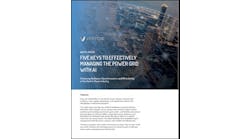Juan Shannon returned to his hometown, Highland Park, Michigan, to move his entertainment business but soon found himself pursuing an even bigger plan: a village where low-income residents get a stake in clean, local energy.
With support from the DOE, the Union of Concerned Scientists (UCS) and others, Shannon is working on developing Parker Village, a smart, sustainable village in Highland Park that will feature clean, low-cost, local energy, including net-zero homes, a solar microgrid, an electric vehicle charging station and an urban garden.
Not only will the neighborhood address the climate crisis and the community’s desire to reduce air pollution, but it will also provide residents with control over their electricity bills and help keep more wealth circulating in their community, rather than being drained by the local utility, said James Gignac, senior Midwest energy analyst for the UCS climate and energy program and the author of a case study that lays out Parker Village’s options for achieving its goals.
The village is expected to feature solar on net-zero homes, with the solar feeding a central battery and controls that form an off-grid community microgrid, said Gignac.
To date, solar streetlights have been installed. The project is expected to be completed in three to five years, said Shannon.
It started with a school
The idea began with Shannon’s purchase of a 43,000-square-foot former elementary school in Highland Park to house his entertainment business, Modern Tribe Communications.
Shannon’s son, a contractor, told him it would cost about $2,000 a month to power the lighting for the former elementary school. Shannon always had an interest in solar, and his son’s warning prompted him to begin researching clean energy options for his space. But the plan kept growing. Shannon looked around at the abandoned houses and vacant property located close to his business, and he hatched a plan to build clean, affordable housing for residents that would also provide him with rental income.
And then came a cafe, and the idea of building a smart neighborhood that would use and showcase energy efficiency and energy technologies. Ideally, the village will be off-grid. With decentralized power, the community could move away from fossil fuels, take control of its energy infrastructure, control rising energy costs and help improve the environment, Shannon said.
But new homes are expensive. Shannon worried about how he could serve existing residents and not push them out of town. So he decided to create a program — which is still in the works — called Clear Paths that would provide tenants a lease-to-own option. They’d make lease payments for 10 or so years, and their lease payments would go toward a down payment on the homes.
“We want to get lower income people into $180,000 or $200,000 homes with a lower utility bill included in the rent,” he said. With solar and energy efficiency, the homes will be competitive with older rentals that go for $650 to $1,200 a month, said Shannon.
The project has already attracted funding. To date, Shannon has spent about $300,000, which includes some of his own money. He was awarded a Detroit Innovation Fellowship grant and funding from the Ford Foundation. Highland Park was also selected to receive technical assistance from the DOE’s Local Energy Action Program (LEAP).
Thanks to support from crowdfunding and major donors, Highland Park-based Soulardarity, a community action group, installed 17 solar streetlights to provide street lighting. Most of the solar lights are located in Parker Village, with others nearby. The DOE has said it will work with stakeholders to help Highland Park move toward 100% clean, local energy.
The Highland Park LEAP project will “advance a clean, efficient and resilient energy future for all Highland Parkers and realize transformational impacts related to energy affordability, community climate resilience, local economic empowerment, and the health and wellness of local residents,” said the DOE.
Making it replicable
To help realize that future — for both Parker Village and other communities — the case study from UCS identified the pros and cons of different scenarios, said Gignac. It looked at options for a microgrid made up of about 1 MW of distributed rooftop solar, along with a central battery, with the cost of the microgrid at about $3 million to $6 million.
“The point of the case study was not only to provide information to Parker Village, but also to provide illustration to other communities and neighborhoods with similar interests in microgrids and the types of options available for communities thinking about microgrids,” said Gignac.
Grid or no grid
For example, the case study looked at the backup options available for a microgrid that is not connected to the main grid. UCS considered the potential for outages, the ability to overbuild solar to provide backup and the community’s interest in focusing on clean energy. The ability to overbuild solar in the dense urban environment is limited, given the focus on keeping the microgrid within the boundaries of the neighborhood. UCS, using HOMER modeling software, looked at gas turbines and diesel generators. But cleaner technology — such as fuel cells — could be an option, said Gignac. UCS continues to look at other non-emitting backup technologies.
Shannon isn’t very interested in using the grid as backup. And that option also creates challenges, said Gignac. The village would have to deal with utility interconnection rules, standby rates and other complexities.
Learn more local energy and community microgrids at Microgrid 2022: Microgrids as Climate Heroes, June 1-2, Philadelphia, Pennsylvania.
UCS didn’t make any recommendations about an ideal solution but instead presented different options.
“The case study was done to provide information to Parker Village and other communities throughout the country interested in local clean energy. They can see the case study as a resource and inspiration. As technology improves, we see clean energy microgrids as realistic and possible for communities,” said Gignac. And, as more communities deploy microgrids, it’s possible they could be networked together, he added.
Options for delivering electricity include creating municipal utilities and rural electric cooperatives, he said.
Rule changes needed
Making Parker Village and other locally owned clean energy systems a reality would be easier if rules and regulations changed. Right now, in Michigan, solar compensation is poor — the state eliminated net metering — and the state doesn’t have many other solar incentives, said Gignac.
He said that what’s needed is either a full retail rate or net metering so rooftop solar can be more attractive for customers. Utilities could also simplify and clarify the process and requirements for connecting microgrids to the larger grid. In addition, utilities should provide more flexibility that would allow local entities to move electricity to different properties, he said.
“We need an overall transition of utilities from the traditional model that utilities generate all the power and serve all the customers to utilities serving as a partner for communities interested in what new technologies can provide,” Gignac said.
Learn more about how local communities are securing microgrids and local energy. Subscribe to the free Microgrid Knowledge Newsletter.








